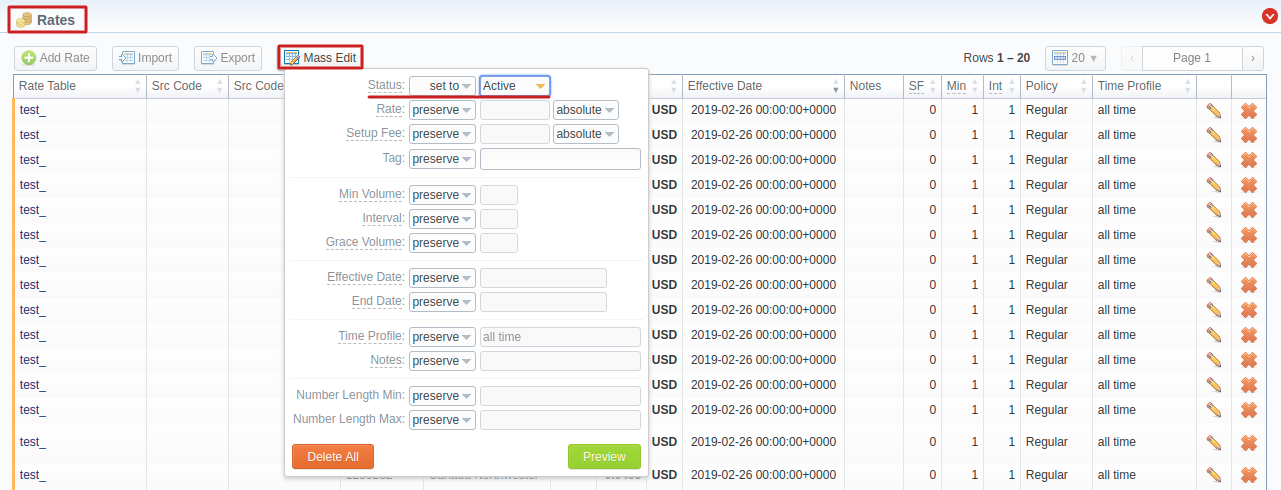Docs for all releases
Page History
...
| Panel | ||||||||
|---|---|---|---|---|---|---|---|---|
| ||||||||
Warning
|
Step 2. Import Settings
The system will recognize the file and display the first and last 5 rows of the first sheet. You will need to select the start and end lines of an import table (marked green). The middle lines are skipped, you can unfold them both ways by five lines by clicking the respective buttons. To switch from one sheet with rates to another, click on a respective tab: i.e., Sheet 1, Sheet 2, etc.
...
| Panel | ||||||
|---|---|---|---|---|---|---|
| ||||||
If you have rates with missing Rate value in the importing file, the system will find the previous rate for the same destination and take this value from there . Also, (if the previous rate was not closed). When when you have rates with missing Effective Date value, the system will take it from the End Date value. |
...
Screenshot: Rates import - Code Rules settings
| Field | Description | |
|---|---|---|
| Code | Indicate a destination code. For all codes, use * (asterisk) | |
| Status | Indicate a status for the rates. By default, it will be Active. Set the Stashed status if you want to double-check them later after import. | |
| Effective Date | Specify a start date of a rate. There are various options to schedule this date:
| |
| Time Profile | Indicate time profile that will be used for a current rate, for example, business time, non-business time, weekends, etc. | |
| Min | Minimal time of the call that will be tariffed. For example, if the total call time was 20 seconds and Min is 30, the client will pay for 30 seconds of the call. | |
| Int | Tariffication interval. This parameter is used, when Min Time time expires. | |
| Extra | Additional parameters are stored under the downwards arrow icon.
| |
...
When the procedure has been executed, you will be forwarded to the Rates tab section where all imported rates will be displayed. They are divided into the following types: Unchanged, Increased, Decreased, New. By clicking on the respective buttons in the top right corner of the tab, you can filter rates by type (see screenshot).
| Panel | ||||||
|---|---|---|---|---|---|---|
| ||||||
Imported rates will be marked as Unchanged, Increased, or Decreased only if their Effective Date value (e.g., 04.25.2018) is higher than Effective Date of a current rate (e.g., 04.10.2018) |
If Auto-Confirm option is disabled, you need to click the Confirm Filtered Rates button (see screenshot) to change rates status from stashed to active.
Screenshot: Confirming Rates
Import History Tab
The tab contains information about all executed imports to this rate table. You can access it in the Rate Tables → Import History. It is presented in a form of table with the following columns:
Screenshot: Import History output
...
...
...
...
Import file. By clicking on the icon, the file will be downloaded
...
File that contains a description of all errors occurred during import. By clicking on the icon, the file will be downloaded
If the Auto-Confirm option was disabled during the import process, you need to Mass Edit the rates' status from stashed to active.
Screenshot: Confirming Rates
Import History Tab
The tab contains information about all executed imports to this rate table. You can access it in the Rate Tables → {Specific Rate Table} → Import History. It is presented in the form of a table with the following columns:
Screenshot: Import History output
| Column | Description | |
|---|---|---|
Date | Time and date of import execution | |
User Login | Login of a user who executed the import | |
File | Import file. By clicking on the icon, the file will be downloaded | |
| Total | Total number of rates from the imported file | |
| New | Total number of rates with New type | |
| Increased | Total number of rates with Increased type | |
| Decreased | Total number of rates with Decreased type | |
| Unchanged | Total number of rates with Unchanged type | |
| A-Z Closed | Number of rates, closed by A-Z import | |
| A-Z Stashed | Number of rates, stashed by A-Z import | |
| Status | Status of import procedure (success/failed) | |
| Error File | File that contains a description of all errors that occurred during import. By clicking on the icon, the file will be downloaded | |
icon | When clicked on, deletes respective import data from the system | |
The imported rates are divided into the following types: Unchanged, Increased, Decreased, New. By clicking on the respective numbers of rates, you can see filtered rates by type (see screenshot above) in the Rates section.
| Panel | ||||||
|---|---|---|---|---|---|---|
| ||||||
Imported rates will be marked as Unchanged, Increased, or Decreased only if their Effective Date value (e.g., 04.25.2018) is higher than Effective Date of a current rate (e.g., 04.10.2018) and they don't have an End Date value. If the End Date value is present in a previous rate, the fresh one will be marked as New. |
...
icon
...




